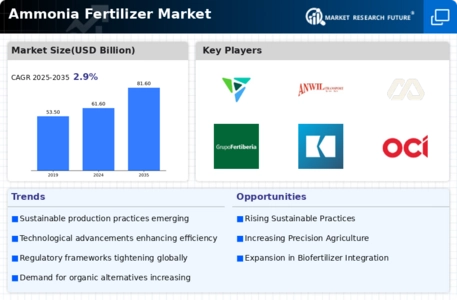Rising Food Demand
The Ammonia Fertilizer Market is experiencing a surge in demand driven by the increasing global population and the corresponding need for food production. As the world population is projected to reach approximately 9.7 billion by 2050, agricultural output must rise significantly to meet this demand. This necessitates the use of ammonia fertilizers, which are essential for enhancing crop yields. In fact, ammonia fertilizers account for nearly 80% of the nitrogen used in agriculture, making them a critical component in food production systems. Consequently, the Ammonia Fertilizer Market is likely to witness robust growth as farmers seek to optimize their yields to satisfy the escalating food requirements.
Global Trade Dynamics
The dynamics of The Ammonia Fertilizer Industry. Changes in trade policies, tariffs, and international relations can influence the availability and pricing of ammonia fertilizers. For instance, countries that are major producers of ammonia fertilizers may experience fluctuations in export volumes due to geopolitical tensions or trade agreements. This can lead to variations in supply and demand, affecting market prices. Additionally, emerging markets are increasingly participating in the ammonia fertilizer trade, which could reshape the competitive landscape. As such, the Ammonia Fertilizer Market must navigate these complexities to ensure stable growth and supply chain efficiency.
Increasing Awareness of Soil Health
There is a growing awareness regarding soil health and its impact on agricultural productivity, which is influencing the Ammonia Fertilizer Market. Farmers are increasingly recognizing the importance of maintaining soil fertility and structure, leading to a higher demand for fertilizers that can enhance soil quality. Ammonia fertilizers, known for their nitrogen content, play a crucial role in replenishing soil nutrients. This trend is likely to drive the demand for ammonia fertilizers as farmers seek to improve soil health and, consequently, crop yields. The Ammonia Fertilizer Market is expected to benefit from this heightened focus on sustainable soil management practices.
Government Initiatives and Subsidies
Government policies and initiatives play a pivotal role in shaping the Ammonia Fertilizer Market. Many countries are implementing subsidies and support programs aimed at promoting the use of fertilizers to enhance agricultural productivity. For instance, various governments have introduced financial incentives for farmers to adopt nitrogen-based fertilizers, including ammonia. These initiatives not only encourage the use of ammonia fertilizers but also aim to ensure food security and sustainable agricultural practices. As a result, the Ammonia Fertilizer Market is expected to benefit from these supportive measures, which could lead to increased consumption and investment in fertilizer production.
Technological Advancements in Fertilizer Production
The Ammonia Fertilizer Market is significantly influenced by technological advancements in fertilizer production processes. Innovations such as the Haber-Bosch process have revolutionized ammonia synthesis, making it more efficient and cost-effective. Furthermore, the development of new catalysts and processes is likely to enhance production efficiency, reduce energy consumption, and lower greenhouse gas emissions. These advancements not only improve the economic viability of ammonia fertilizers but also align with the growing emphasis on sustainable agricultural practices. As a result, the Ammonia Fertilizer Market is poised for growth as producers adopt these technologies to meet the increasing demand for fertilizers.

















Leave a Comment